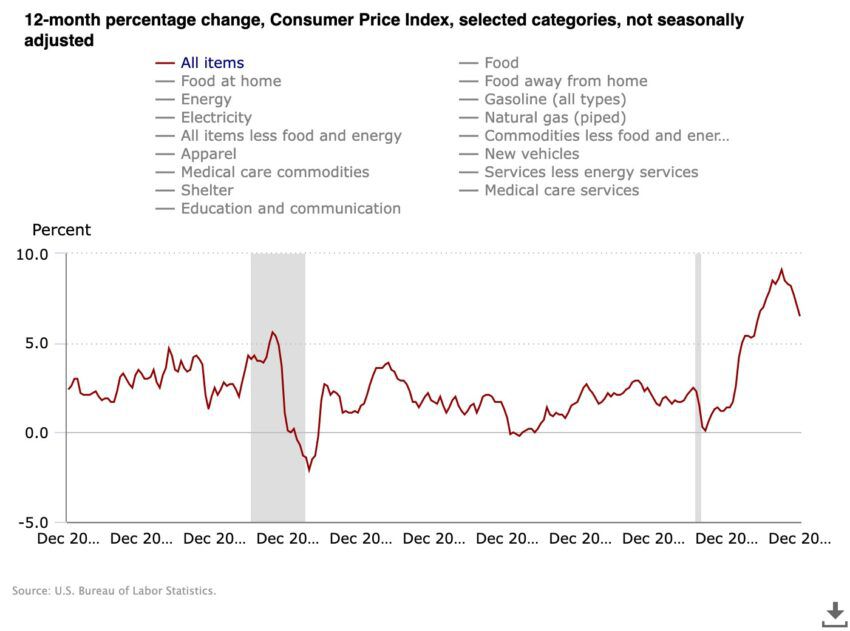CPI Data to Challenge Disinflation Optimism: Insights to Watch For This Week

As investors prepare for a busy week ahead filled with a packed economic calendar, they have their sights set on one key piece of data: inflation.
The release of January’s Consumer Price Index (CPI) from the Bureau of Labor Statistics on Tuesday is highly anticipated, especially after Federal Reserve Chair Jerome Powell acknowledged the presence of “disinflation” in the US economy.
Inflation Data Expected to Impact Stock and Crypto Markets
According to economists, the headline CPI is expected to have risen 0.5% month-over-month in January, a significant increase from recent months. The Bureau of Labor Statistics released new seasonal adjustments last Friday, which revised December’s initial monthly drop in headline inflation from 0.1% to an increase of 0.1% in the year’s final month.
According to Bloomberg’s consensus estimates, despite the expected monthly rise, the annual headline number is projected to decrease to 6.2% from 6.5% the previous month.
One of the key metrics monitored by the Federal Reserve, the core CPI, is forecast to show a 0.4% rise over the month after removing the volatile food and energy components. On an annual basis, economists expect the core CPI to have risen 5.5% over the year, a modest decrease from 5.7% in December.

Source: US Bureau of Labor Statistics
Policymakers focus more closely on core inflation as it provides a nuanced look at key inputs like housing, while the headline CPI has largely been affected by volatile energy prices this year. For Chair Powell, shelter inflation, which has remained stubbornly high, is a crucial factor in determining the path of interest rates.
In a recent interview in Washington D.C., Powell stated that he expects housing inflation to decline by the middle of the year.
“There has been an expectation that [inflation] will go away quickly and painlessly; I don’t think it’s guaranteed that’s the base case,” Powell said last Monday at the Economic Club of D.C. “It will take some time.”
CPI, PPI, and More Financial Reports
In addition to the CPI, Wall Street will also have an opportunity to gauge inflation at the wholesale level with the release of the Producer Price Index (PPI) on Thursday. The government’s retail sales report, due on Wednesday, is expected to show continued strength in consumer spending.
The PPI is forecasted to have risen 0.4% over the prior month, a bounce back from December’s decline of 0.5%. On an annual basis, economists expect the PPI to have fallen to 5.4% from 6.2% in December.

Source: US Bureau of Labor Statistics
Retail sales are expected to have rebounded in January, rising 1.9% over the prior month following a 1.1% decline in December.
Despite a strong start to 2023, US stocks and Bitcoin experienced their worst week of the year last week. The S&P 500 closed down 1.1%, the Dow Jones Industrial 0.2%, the Nasdaq Composite 2.4%, and Bitcoin 5.05%.
Analysts at Bespoke Investment Group noted:
“Given the strong rally to start the year, the market was due for a cool-off period, and we got that this week.”
Investors have seen equity markets rebound sharply since December on the anticipation that the Federal Reserve may pause rate hikes sooner than expected. However, officials and strategists continue to assert that excitement around a potential pivot is premature.
Investors will also be closely watching the January CPI data, as it will give them an insight into the economy’s direction. If the data comes in lower than expected, it could indicate that the economy is slowing down, which could be a negative for stocks and cryptos. On the other hand, if the data comes in higher than expected, it could signal that the economy is gaining momentum, which would be positive for stocks and cryptos.






 Bitcoin
Bitcoin  Ethereum
Ethereum  Tether
Tether  USDC
USDC  TRON
TRON  Dogecoin
Dogecoin  Cardano
Cardano  Bitcoin Cash
Bitcoin Cash  Chainlink
Chainlink  Monero
Monero  LEO Token
LEO Token  Zcash
Zcash  Stellar
Stellar  Litecoin
Litecoin  Hedera
Hedera  Dai
Dai  Cronos
Cronos  Tether Gold
Tether Gold  OKB
OKB  Ethereum Classic
Ethereum Classic  KuCoin
KuCoin  Gate
Gate  Algorand
Algorand  Cosmos Hub
Cosmos Hub  VeChain
VeChain  TrueUSD
TrueUSD  Dash
Dash  Tezos
Tezos  Stacks
Stacks  IOTA
IOTA  Basic Attention
Basic Attention  Theta Network
Theta Network  Decred
Decred  NEO
NEO  Synthetix
Synthetix  Qtum
Qtum  Ravencoin
Ravencoin  DigiByte
DigiByte  0x Protocol
0x Protocol  Nano
Nano  Zilliqa
Zilliqa  Holo
Holo  Siacoin
Siacoin  Numeraire
Numeraire  Waves
Waves  BUSD
BUSD  Status
Status  Enjin Coin
Enjin Coin  Pax Dollar
Pax Dollar  Ontology
Ontology  Hive
Hive  Lisk
Lisk  Steem
Steem  Huobi
Huobi  OMG Network
OMG Network  NEM
NEM  Bitcoin Gold
Bitcoin Gold  Augur
Augur  Ren
Ren  HUSD
HUSD